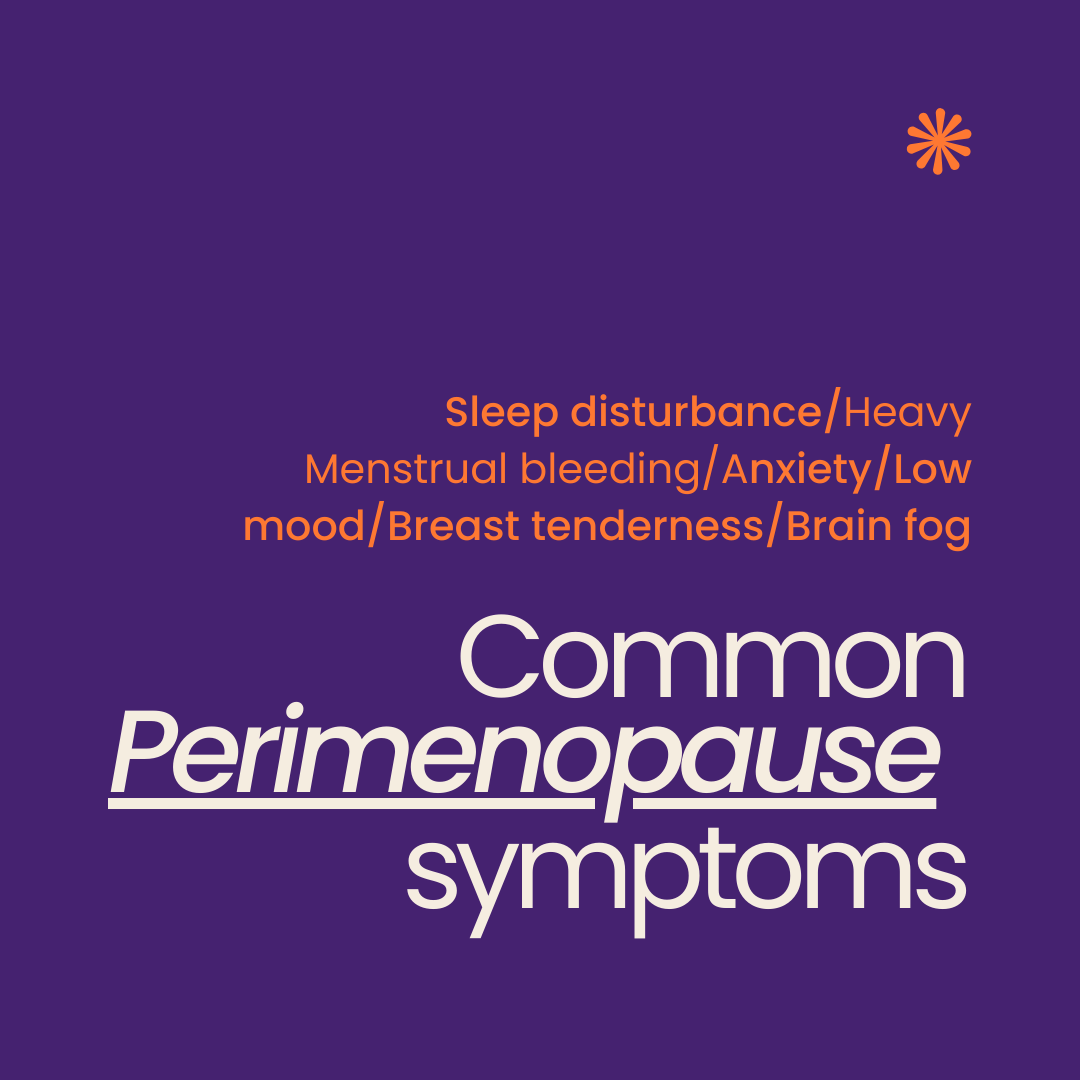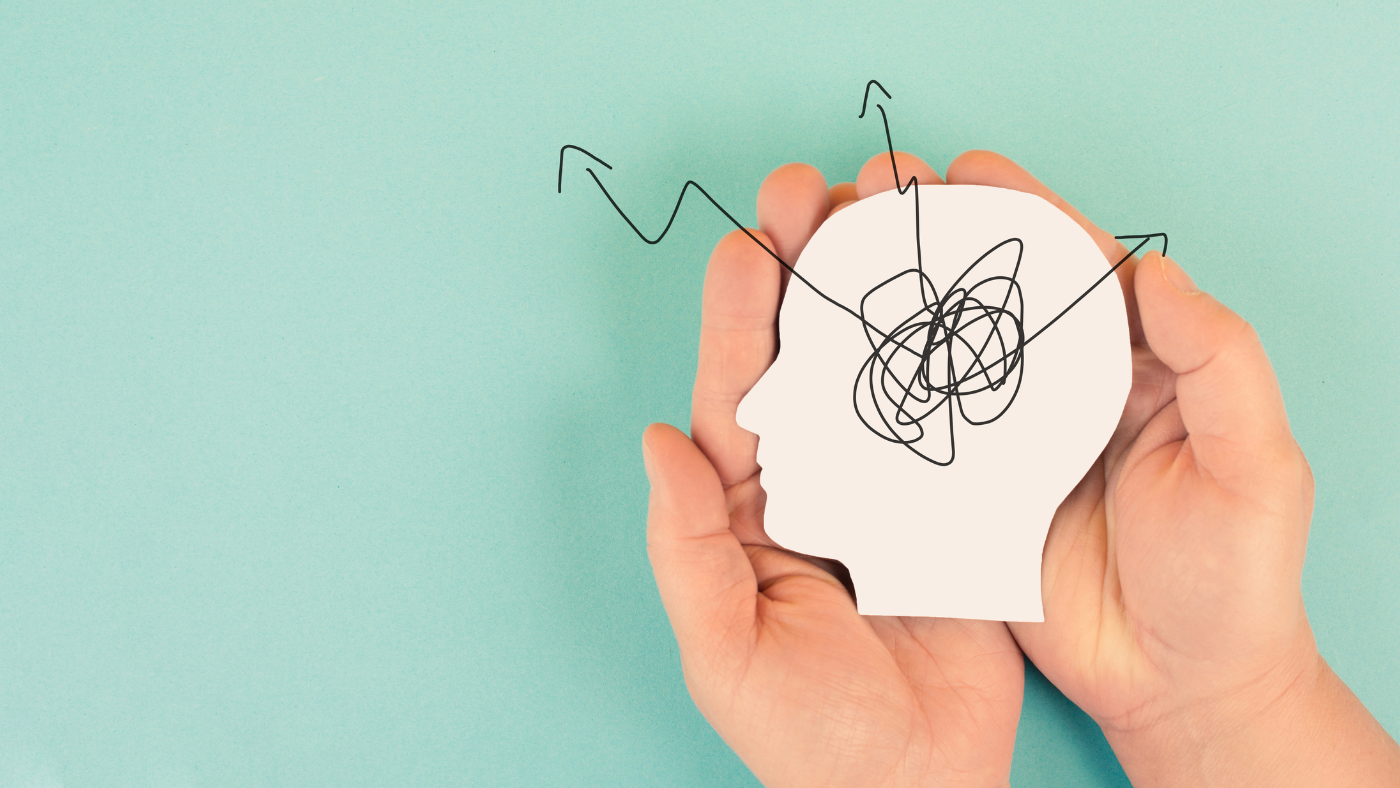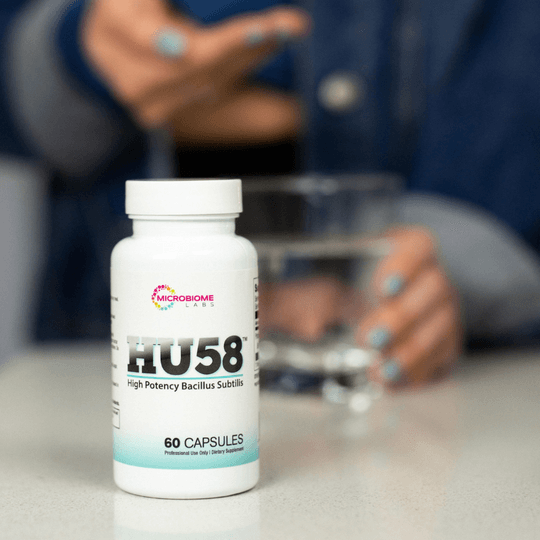Perimenopause: The Journey from Reproductive Vitality to Empowered Change
Presented by Immanence Health
Written by Heathar Parisi, FNP-C
Decoding perimenopause can pose a unique challenge. A woman's reproductive health undergoes notable changes across her lifetime. From the onset of her first menstrual period through the reproductive childbearing years and onward to menopause, hormones play a pivotal role, driving distinct shifts at each stage. In this blog post, we'll delve into the details and nuances of the perimenopausal hormonal shifts and how they connect us to our post-menopausal years.
What is Perimenopause and how do I know if I’m experiencing it?

Every woman's hormonal experience through life is unique, and one of the transformative phases women encounter with a bit of confusion is perimenopause. This natural transition, often shrouded in misconceptions, brings about significant changes in the body. Let’s unravel the essence of perimenopause, explore its common symptoms, discuss lifestyle strategies, and touch on the potential role of Bio-Identical Hormone Replacement Therapy (BHRT) in empowering you to navigate this time with confidence and some actionable tools. Understanding the dynamics of how your body changes during perimenopause is the first step toward a smoother journey.
What is Perimenopause?
Definition:
Perimenopause, also known as the menopausal transition, is a natural phase that typically begins in a woman's late 30s or early 40s. Peri is the prefix meaning about or around. Perimenopause marks the gradual biological decline in ovarian function and hormonal changes leading into menopause.
What It Isn't:
Contrary to misconceptions, perimenopause is not a sudden endpoint. It's a progressive phase that can last anywhere from a few years to over a decade. It not only affects our ovaries and uterus but has ramifications on our metabolic, immune, neurologic, and cardiovascular systems, just to name a few! It is distinct from menopause itself. Menopause lasts for one day and is officially declared when a woman has not had a menstrual period for 12 consecutive months. After that, you are considered post-menopausal. I know that sounds “old” but I don’t have any control of the nomenclature, unfortunately. Otherwise, I’d call it the Wise Goddess phase! 🫅🏼🤩💃🏼
Common Symptoms of Perimenopause:
Perimenopause can manifest in various ways and every woman’s experience is based on multiple factors including genetics, lifestyle choices, and as always, stress. Common symptoms include but are not limited to:
- Irregular menstrual cycle length
- Sleep disturbances
- Heavy menstrual bleeding
- Breast tenderness
- Fatigue
- Irritability
- Missed periods
- Mood swings
- Anxiety, Depression, or Both
- Brain fog
- Word finding challenges
- Infertility
- Headaches and migraines
- Stubborn weight gain
- Hot flashes and night sweats
- Low libido
- Vaginal dryness
- Increased urinary frequency
- Urinary tract infections
- Pelvic floor weakness
Estrogen is a master regulator that functions through a network of receptors exerting beneficial effects on a myriad of body systems, including cardiovascular, bone, and brain. Symptoms often arise due to the ever-evolving adjustments the brain and body are making in response to changing hormone levels. Some women may only encounter mild symptoms, while others find their symptoms debilitating. External factors like exposure to toxins, poor diet, and sedentary behaviors can exacerbate symptoms.
The encouraging news is that several lifestyle factors influencing our perimenopause experience are within our control. And, in fact many women report feeling more grounded, stable, and confident on the other side.
Adopting healthy habits early on can effectively soothe many of the discomforts associated with perimenopause. But I’m meeting you today, wherever you are because it’s never too late to start and experience a good return on investment. Let's explore some concrete steps you can take to navigate perimenopause with greater comfort and well-being.

Lifestyle Strategies for a Smoother Transition:
Getting the fundamentals dialed in is of utmost importance no matter what life stage you find yourself in, particularly in phases of higher demand on the body. Please do not underestimate the power you have by consciously putting your attention on implementing these strategies. These are my top 4.
1. Prioritize Sleep: Getting you Zzzz’s
There is no skimping on sleep during perimenopause, ladies. It has been well documented that perimenopausal women have higher levels of psychological distress compared to pre-menopausal women and therefore their sleep requirements are increased. In addition to the hormonal changes, many of us are managing our careers, still raising our kids at home, possibly taking care of aging parents, and other stressors. So, establishing healthy sleep habits is crucial. Create a calming evening routine you look forward to (a bath, reading, or meditation), limit screen time 1-2 hours before bed, and ensure your sleep environment promotes restful sleep (dark, quiet, and cool room). Many sleep experts have found that a consistent bedtime and wake time are beneficial for enhancing sleep quality and restoration. If you’re a night owl or are struggling with sleep issues, supplemental melatonin before bed and early morning sun exposure outside can help naturally adjust your circadian rhythm and reset your sleep drive. If you live in a cloudy or dark climate, consider substituting a light panel or light visor. See more on melatonin usage in the supplement recommendations below. If I haven’t totally sold you on the value of this yet, check out sleep expert Dr. Matt Walker’s TED talk titled, Sleep is your Superpower.
2. Balanced Nutrition: Having a framework but letting go of rigidity.
It makes sense that eating well during a stressful time is a good idea. You may find yourself leaning into comfort foods looking for a little dopamine hit and on occasion, that’s completely okay. I always recommend the 80:20 rule to patients. 80% of the time, eat within whatever healthy framework you design, emphasizing nutrient-rich foods that include the colors of the rainbow, well-sourced proteins, and over 40 grams of fiber per day. The other 20% of the time, play with flexibility, whether it’s eating out at your favorite restaurant, having some dessert, or enjoying whatever other treat that suits your fancy. Adequate intake of vitamin D & K becomes increasingly important for bone health, too. Oily fish, including salmon, mackerel, and sardines as well as egg yolks, red meat, and liver are all good sources. Bone density can be affected by estrogen and progesterone fluctuations which are typical during this phase. It’s estimated that perimenopausal women lose around 2.5% of their bone density per year due to the loss of sex hormones. So, be cognizant of your intake and if you don’t make the mark, consider supplementation. On lab testing, we like to see an optimal Vitamin D level of around 50 ng/mL or higher.
3. Regular Exercise:
Movement is vital in all stages no matter your age, but the need increases even more so when physiological stress is at the top of the menu. Make the effort to incorporate regular physical activity into your routine every day. This can look like something as simple as parking further away and walking the lot, taking the stairs instead of the elevator, take a walk with your friends instead of sitting for coffee. Take a 5-minute break to dance to your favorite couple of feel-good songs. This will absolutely put a smile on your face. Another useful tip is to use an activity tracker or smartphone app that counts steps and heart rate variability. This can be a motivational way to track your progress. Exercise has been shown to alleviate some perimenopausal symptoms, help maintain bone density, improve mood, and support overall well-being. I’ve found working out with a trainer twice a week has upped my fitness game in a big way. My body feels so much stronger, I walk taller, and I’m held accountable to be there because of the personal and financial commitment. That was something I discovered I needed to keep me on track. What are your motivating factors?
4. Stress Management:
Practicing stress-reducing techniques such as meditation and deep-breathing exercises ahead of the stressor builds resilience. Think about this as more of a proactive approach that is particularly effective in preparing your mind and body to respond calmly under stress. It’s like dollars in a savings account. Managing stress whether it is physical, spiritual, or psychological is integral to easing the emotional aspects of perimenopause. Consistent meditation works well to decrease a maladaptive emotional response. In today’s society, knee-jerk reactions have become the norm in almost every stressful situation, major or minor. Then we have the opposite end of the spectrum. The part of us that attempts to control these feelings and not react at all. Learning to regulate emotions through meditation is a valuable skill that will reap benefits you don’t want to miss out on. Regulating emotional response is different than attempting to control. The concept of control often implies a tense and constricted suppression or even total avoidance, AKA: checking out. While controlling emotions may alter how we outwardly express our feelings, it doesn't transform the emotional experience. In addition, this false sense of control has the downside of physical and cognitive costs. The practice of awareness during meditation helps us catch heated emotions in the moment and process information more effectively. This progressive paradigm shift allows the individual to make a different choice and maybe even consider their contributions to the situation, all the while softening the perception of what’s happening. It’s a powerful way to maintain emotional balance and create a physiological and psychological reserve for the changes the body is going through during perimenopause. If you’re a tech nerd like me, a supportive modality to incorporate into your practice is the HeartMath Inner Balance device. It’s a wired ear clip sensor you can plug into your smartphone (also available with Bluetooth if you choose) that provides real-time biofeedback results. It shows measurable progression of your practice which translates into positive benefits like an uplifted mood, increased sleep quality, and an overall improvement in symptom management. And the associated apps like Inner Balance and Global Coherence are worthwhile free additions to the device. You can literally meditate with the world!
BHRT as a Potential Treatment
Understanding BHRT:
Bio-identical Hormone Replacement Therapy (BHRT) involves using hormones that are structurally identical to those naturally produced by the body. These hormones can include estrogen, progesterone, and testosterone. Some women may find this concept counterintuitive when they are experiencing symptoms of estrogen dominance. But here's the scoop; in our mid to late 40’s, as we are headed towards ovarian retirement, our brain can be continually triggered due to unfamiliar declining estrogen levels at times in the cycle when supply would normally be adequate in the blood. When this occurs, the brain sends out an SOS to the ovaries to produce more estrogen. The problem is that the signal is oftentimes too loud and aggressive. So, the ovaries overcompensate and make an excessive amount, which leads to the estrogen-dominant symptoms of heavy bleeding, longer periods, hormonal migraines, and breast tenderness. So, if we gently replace and level out estrogen throughout the month, we avoid the triggering and the excess compensation of estrogen production and release as a result. In addition, it’s quite common in this age range to have anovulatory (no ovulation) cycles. If you don’t ovulate, you don’t make adequate progesterone for that month and that’s not a good thing. Progesterone provides balance to estrogen’s growth-like effects as well as contributes to restful sleep and a calm balanced mind through its reciprocal relationship with GABA receptors. So, even missing just one month can feel unpleasant and result in symptoms.
But, before jumping into BHRT, there are several herbs and supplements to consider that can be very helpful in mitigating some of the undesirable symptoms.
1. DIM (Diindolylmethane):
- Role: Derived from cruciferous vegetables, DIM is known for its potential to support hormone balance, particularly by promoting the metabolism of estrogen in the liver. Benefits include helping to alleviate symptoms related to estrogen dominance, such as heavy periods and breast tenderness.
- Source: Found in cruciferous vegetables like broccoli, cabbage, and brussels sprouts. DIM supplements are also available.
- Click here to see product >
2. Maca:
- Role: Maca is a root vegetable native to the Andes. It's an adaptogen that helps the body adapt to stress and balances hormones. Some women report improvements in energy, mood, and libido. It's also recommended to help manage symptoms like hot flashes.
- Source: Available as a supplement and often used in powdered form. Maca can also be incorporated into smoothies or taken in capsule form.
- Click here to see product >
3. Omega-3 Fatty Acids:
- Role: Supports heart health, reduces inflammation, increases cellular membrane health, and may help alleviate mood swings.
- Source: Fatty fish (salmon, mackerel), flaxseeds, chia seeds, and walnuts. Supplements like fish oil can be considered.
- https://ipothecarystore.com/products/arctic-cod-liver-oil-lemon-180-gels
- Click here to see product >
4. Vitamin B Complex:
- Role: Supports energy metabolism and helps manage stress. This is a must for perimenopause.
- Source: Whole grains, leafy greens, meat, and dairy. A B-complex supplement can be considered along with a healthy dietary intake.
- Click here to see product >
5. Black Cohosh:
- Role: Studies suggest it may help alleviate hot flashes and mood swings. It may be best to use in a combined formula with other botanicals. A consultation with an herbalist or a well-versed practitioner is recommended to get your perfect blend.
- Source: Available as a supplement usually in tincture. Consult a healthcare professional before use.
6. L-Theanine & Melatonin:
- Role: These two relaxation powerhouses can help you get a good night’s rest especially when used in combination. L-theanine can be taken in the early evening as a preparation for relaxation. Melatonin can be taken just before bed. Interestingly, studies have shown that melatonin in a low dose, such as 0.5 mg, is better for sedation versus the larger doses most supplements provide.
- Source: L-Theanine can be found in green tea and capsule form. Melatonin is available in capsule or liposomal formulations.
- Click here to see product >
- Click here to see product >
7. Probiotics:
- Role: Supports gut health, which is linked to overall well-being, including mood and immune function. A healthy gut is very important for the last phase of estrogen detoxification. Dysbiosis can cause the recirculation of partially detoxified estrogen that’s on its way out of the body, due to an overabundance of an enzyme called beta-glucuronidase. Probiotics can help keep this enzyme in check as well as keeping the bowel healthy for elimination.
- Source: Fermented foods (yogurt, kefir, sauerkraut) and probiotic supplements.
- Click here to see product >
Conclusion:
Understanding perimenopause is a powerful way to navigate this transitional phase. By recognizing common symptoms, implementing proactive lifestyle strategies, and exploring potential treatments like herbs, supplements, and BHRT under professional guidance, you enhance your self-care and embrace the changes your body undergoes. Empower yourself with knowledge and resilience as you journey through perimenopause finding grace and ease along the way. And remember one last thing…this is temporary.
Additional Sources:
- Cano A. Menopause: A Comprehensive Approach. Berlin: Springer; 2017.
- Metcalf, C.A.,… Cognitive Problems in Perimenopause: A Review of Recent Evidence. Curr Psychiatry Rep 25, 501–511 (2023). https://doi.org/10.1007/s11920-023-01447-3
- Ciappolino V,... N-3 Polyunsatured Fatty Acids in Menopausal Transition: A Systematic Review of Depressive and Cognitive Disorders with Accompanying Vasomotor Symptoms. Int J Mol Sci. 2018 Jun 23;19(7):1849. doi: 10.3390/ijms19071849. PMID: 29937484; PMCID: PMC6073395.
- Sung MK,… Potential Association of Meditation with Menopausal Symptoms and Blood Chemistry in Healthy Women: A pilot cross-sectional study. Medicine (Baltimore). 2020 Sep 4;99(36):e22048. doi: 10.1097/MD.0000000000022048. PMID: 32899065; PMCID: PMC7478772.
- McCarthy M, Raval AP. The Perimenopause in a Woman's Life: A Systemic Inflammatory Phase that Enables Later Neurodegenerative Disease. J Neuroinflammation. 2020 Oct 23;17(1):317. doi: 10.1186/s12974-020-01998-9. PMID: 33097048; PMCID: PMC7585188.
About Heathar Parisi, FNP-C
Advanced Nurse Practitioner, Heathar Parisi, is a women’s health and hormone expert. As a family nurse practitioner, herbalist, and functional medicine provider, she uses a holistic approach when treating women in perimenopause and menopause, always keeping connection and humor as the centerpiece of her interactions. She has specialty training in the Menopause Method for the use of BHRT through the Institute of Bioidentical Medicine (IOBIM). She is a mother of three and resides in Scottsdale, AZ with her family. Consultations are available through Immanence Health.
To learn more about working with
Heathar Parisi, FNP-C
in person or virtually (US and Worldwide), set up a free discovery call with our team.
Disclaimer: this post is for informational purposes only and is not meant to treat, diagnose, cure, or prevent any disease. Please do your own research and consult with your own personal licensed health care provider before making any treatment decisions.

Dr. Christine Schaffner
Founder / Physician
Dr. Schaffner is a board-certified Naturopathic Doctor and recognized thought leader. After graduating from Bastyr University in Seattle, Washington, Dr. Schaffner completed her undergraduate studies in Pre-medicine and Psychology at the University of Virginia in Charlottesville.
With her diverse skill set, Dr. Schaffner seeks to improve access, outcomes, and speed of recovery for patients struggling with chronic illness, from all around the world and combines both naturopathic and conventional therapies to develop individualized treatment plans that focus on addressing the underlying cause of complex chronic illness.
Dr. Schaffner is passionate about educating patients, as well as other practitioners, bringing the most advanced medical protocols to all, as well as creating spaces for healing and rejuvenation. Her style of practice is strongly rooted in traditional naturopathic principles, including removing toxins and establishing a strong health foundation in order to achieve optimal health.
You can learn more about Dr. Schaffner at www.drchristineschaffner.com.
Additional Articles



Call Now: ph (206) 659-0690
Seattle Location
1629 Queen Anne Ave N, Ste 104
Seattle, WA 98109
ph (206) 659-0690
The material on the Website is provided for general informational purposes only and is not intended as medical advice, or as a substitute for the medical advice of a physician. The statements made on this Website have not been evaluated by the Food and Drug Administration and are not intended to diagnose, treat, cure or prevent any disease.